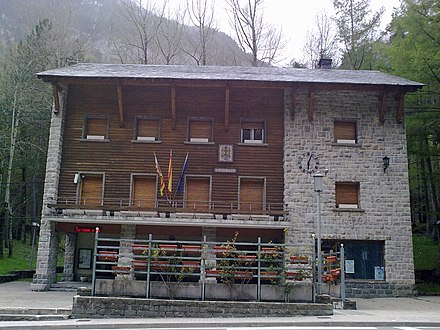Canfranc - municipality of Spain

Canfranc is in Aragon, Spain. It consists of two villages, the original village, which has fewer than 100 residents, and Canfranc Estación, which developed with the establishment of Canfranc international railway station to serve railway traffic across the Pyrenees. It has about 450 residents
Understand
This rather small village would be a perfectly un-notable community in the Pyrenees mountains if it hadn't been chosen in the 1920s as the site of a Spanish-French border station. Among other things, it served as a point where Nazi gold was delivered from Vichy-France to Franco-Spain. It was also the main transshipment point for war-critical tungsten from officially neutral Spain to Nazi-controlled Europe. However, an accident in the 1970s left the line without cross-border traffic and while traffic from the Spanish side to Canfranc has resumed and there are some ideas on the French side of reopening traffic, the station - and all the infrastructure built to support it - seems weirdly out of place and way overbuilt.
Get in
By road
The N-330 road climbs from Jaca. Canfranc is the last Spanish town before the road enters a tunnel which takes it through the mountains to France, where it becomes the N134, which continues as far as Pau. Jaca and Pau offer motorway access in their respective countries; the A-23 (Huesca-Zaragoza/Lerida) in the case of the former, and the A64 (Bayonne-Toulouse) and A65 (Pau-Bordeaux) for the latter.
By train
Canfranc is at the northern end of a railway line from Zaragoza. Renfe operates two services a day in both directions, stopping en route at Huesca and Jaca. Despite its name, the station is not served by any international trains; the Pyrenean rail tunnel closed in the 1970s, and while there is a project to restore cross-border services, it's a way off being complete. As of 2020, Canfranc receives SNCF buses from the closest station on the French side of the border, Bedous 📍, where services to and from Pau are operated by TER Nouvelle Aquitaine.
- Canfranc International railway station (Estación Internacional de Canfranc). 2021-04-10
Get around
See
- Canfranc International railway station (Estación internacional de Canfranc), 42.75128°, -0.5146°. This station is without a doubt the main draw of Canfranc and "what put it on the map". While these days there are once again trains from Spain via Huesca, traffic from France which was not interrupted by the Second World War ceased in the 1970s after an accident damaged the railway infrastructure and it was decided not to rebuild it. Various stories of differing degrees of plausibility and truthfulness surround the station, including tales of daring escapes, espionage, smuggling and human tragedies and comedies. The station shows signs of its age and of large parts of it having been unused for decades, but in summer 2018 works to renovate the station were begun, and as of 2023 it is a hotel. 2020-05-04
- Castillo de los Arañones, 42.735447°, -0.523428°. A 19th-century defensive fort. 2019-01-03
- Iglesia de Nuestra Señora del Pilar, 42.716389°, -0.525278°. A local church dating to the 20th century. The architecture is humble but impressive in its own way. 2019-01-03
Do
Buy
Eat
Drink
Sleep
- Canfranc Estación, 42.75128°, -0.5146°, +34974561900, canfrancestacion@royalhideaway.com. Check-in: 15:00, check-out: 12:00. Opened in 2023, this 5-star hotel occupying the Canfranc Station has the charm of the early 20th century and the luxury of the 21st century, with over 100 rooms, a bar, a wellness center, and a pool (€15 to use). €150 2023-02-17
Connect
Go next
Canfranc
canfranc.comProvincia de Huesca
2nd-order administrative division
Aragon
Primary administrative division
